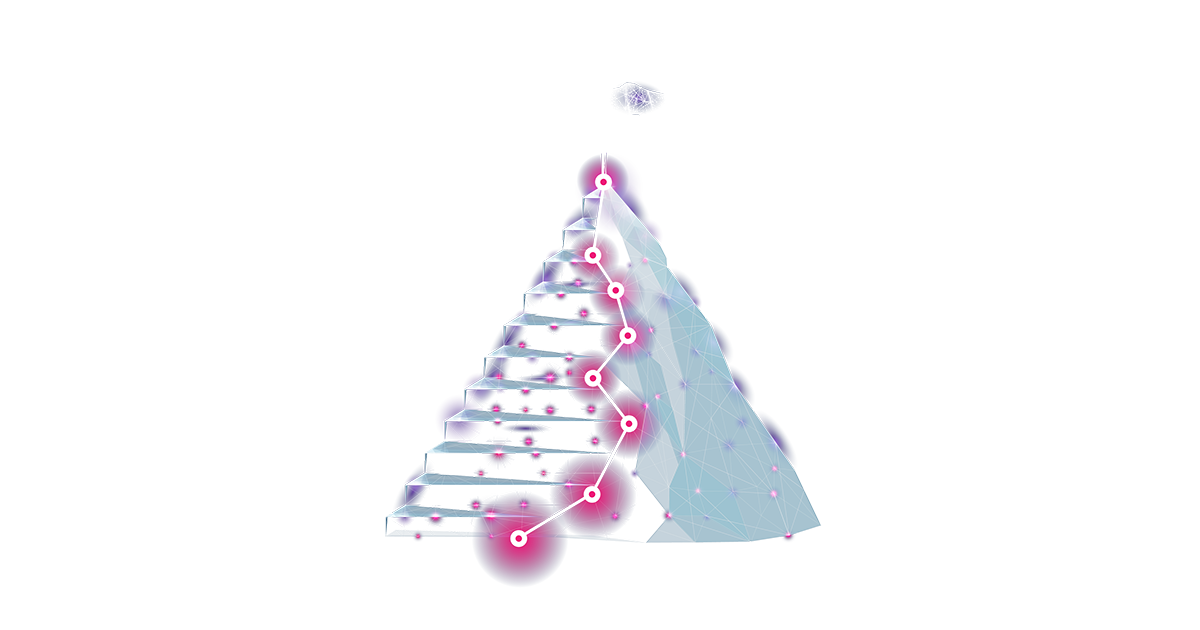
What you should know about the sales planning process
Ask a sales executive for an example of a riddle, and it’s very likely that they will bring up the sales planning process. The importance of sales planning is not in question. Regardless of the industry sales executives are in, they consider sales planning a critical and strategic activity – and rightly so. The process offers a glimpse into the future development of the company.
Sales volume – an important factor of sales planning
How much can we sell? Which markets should we cover? The answers to these questions are critical. Not only do they drive revenue, but they also help determine the number of people you can employ at what salary; they tell you how much material or goods you will need, and when to purchase them. Indeed, the volume of business drives nearly everything in a company, and that volume is defined by sales planning.
As such, it’s not surprising that survey after survey shows: The sales planning process is an extremely high priority for enterprises. Now, the riddle is that despite their commitment to it, sales planning is also consistently cited by companies as not meeting expectations.
What are the problems in sales planning?
Unlike other planning processes that are based on consistent or easily deducible factors, sales planning is subject to continual change and must be flexible to meet changing demands. In today’s global markets, driven by volatile demand and serviced by increasingly decentralized and complex networks, that change is accelerating. Getting a handle on all this is a tough nut to crack.
According to a recent survey by Gartner, improving forecast accuracy is in second position on the list of top-priority corporate goals. The same study shows that, despite this, serious performance gaps (i.e., the difference between levels of importance and performance) persist.
Chief among them in sales planning:
- Developing detailed demand plans (28 percent gap)
- Collecting relevant sales and market data (26 percent gap)
- Communicating the plan and measuring its effectiveness (23 percent gap)
- Aligning the demand, supply, and financial plans (19 percent gap)
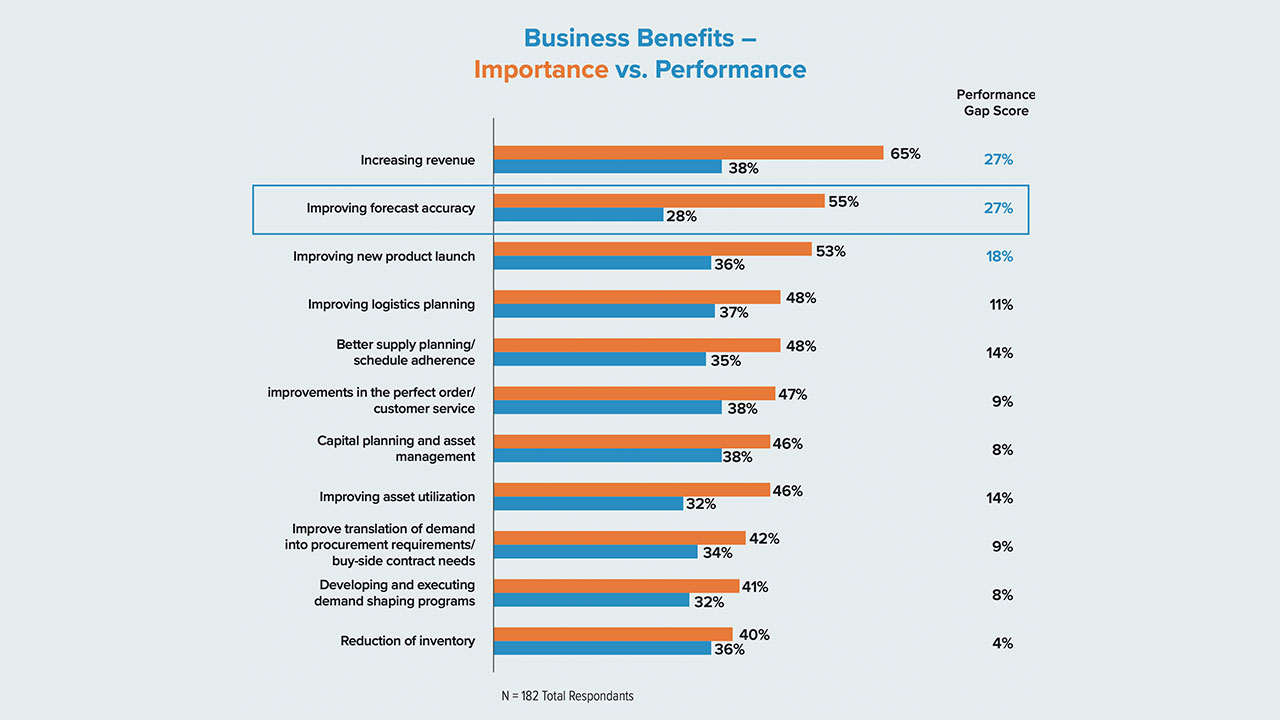
Source: Gartner (Business Benefits – Importance vs. Performance)
What is creating performance gaps in sales planning?
A report published by Supply Chain Insights lists the five top challenges that enterprises see as impeding successful sales planning processes:
- Problem: 72% had difficulty in getting to the right data in a timely fashion.
Solution: Use of tools for planning and visualization - Problem: 53% said the process was not balanced.
Solution: Reconcile sales, operations, controlling and product launch - Problem: 50% cited a lack of understanding.
Solution: Driving value creation strategies at management level - Problem: 50% noted a lack of skilled resources.
Solution: Investment in competencies for “What-if”-analyses - Problem: In an average company, 4 sales planning processes are underway at all times.
Solution: Combine planning and implementation
Source: Supply Chain Insights (Top 5 Challenges to an Effective S&OP Planning)
The challenge: simplifying processes and creating conclusive reports
One of the main challenges of the sales planning process is determining the proper scope and balance between details and general overview. If the process gets too detailed, chaos may ensue from the sheer number of figures, as well as the computing power needed to process them. Hard questions need to be asked: Do the reports being generated actually add value? Are they providing the basis for effective control and execution of the plan?
If the process is too coarse, the business lacks sound forecasts and will be held back by this. In the end, you might only know that your targets have been missed, but not understand how or why. So having the right level of granularity is key, as well as determining the right levels for what is subject to change. Put simply, you need to figure out what is really needed.
Many companies still try to do this process in Microsoft Excel, only to find they quickly reach the technical limitations of the program. This often leads to static or blunted planning because it’s so difficult to stay on top of and maintain a large number of spreadsheets.
In fact, Excel is not ideal for handling complexity or growth – the first being an essential component of today’s business world, the latter the very goal of the sales planning process!
Sometimes controlling or accounting departments create Excel templates for their sales teams, which they forward to the sales executives. In turn, the sales executives pass these templates on to their teams so staff can enter their data for the next planning period. The spreadsheets then go back to controlling who consolidate all the numbers. The process ends up being an extensive “back and forth” which is both time consuming and error prone. In this “data jungle”, it’s very easy to lose track of important information, and version control becomes an ongoing problem.
When companies turn to more sophisticated database software, the problem can often be the reverse: the natural tendency is to overdo things. Therefore, experienced, and successful planners always strive to find the right balance, to make processes easier, and to set up data structures in a way that makes sales planning smoother for users and management alike.
Use Case: Fiat
Fiat is much more than an innovative car maker. The company develops utility vehicles, production facilities, and industrial robots. Fiat employs more than 225,000 people worldwide and manages 16 brands, among them Alfa Romeo, Lancia and Jeep.
Fiat Germany provides tailored distribution, sales and automotive services through its motor villages.
They manage direct sales, business customers and partners, as well as provide maintenance and repair. Fiat Germany’s financial controlling department used legacy reporting and Excel to report and plan quarterly forecasts for European headquarters.
Increased risk of error through static Excel sheets
It was in these legacy systems that the company discovered a flaw: Planning data took a detour through static Excel sheets before being uploaded. Updates of crucial forecast information required excessive manual work, increasing the risk of human error. Additionally, the system could not model the complex calculation logic for enterprise planning and the P&L. The situation generated substantial excess expenditure for Fiat’s dealerships, which were consolidating their data under considerable time pressure. Night shifts to prepare the quarterly forecasts had become the rule rather than the exception.
Dispersed planning data meant “Excel hell” with data in 30 different spreadsheets, each one needing adjustment and manual consolidation for every minor change. Fiat was losing time gathering and reconciling data, and couldn’t support fact-based decision-making in real time. The data cycle between HQ and the planners in Fiat subsidiaries tied up valuable resources, with expenditures rising monthly in an effort to complete planning in time.
To respond with more agility to HQ’s evolving forecast requirements and to facilitate and accelerate data consolidation and preparation for all 15 subsidiaries, Fiat turned to Jedox Suite, a modern reporting solution with advanced planning functionality. The new solution needed minimal administration, with business users able to adjust reports and planning logic quickly and independently.
A single source of truth across all departments facilitates cooperation and planning
The company now has daily visibility of actual versus plan KPIs from reports and quarterly forecasts and is able to complete monthly budget-actual comparisons, and have weekly forecast calls with HQ. Sixty users at Fiat across diverse departments can now access high-quality data in one consistent environment and benefit from easy administration. Managers can enter planning data for sales, staff, and administration independently using the unified data model.
Fiat forecasting 10x faster with integrated Jedox solution
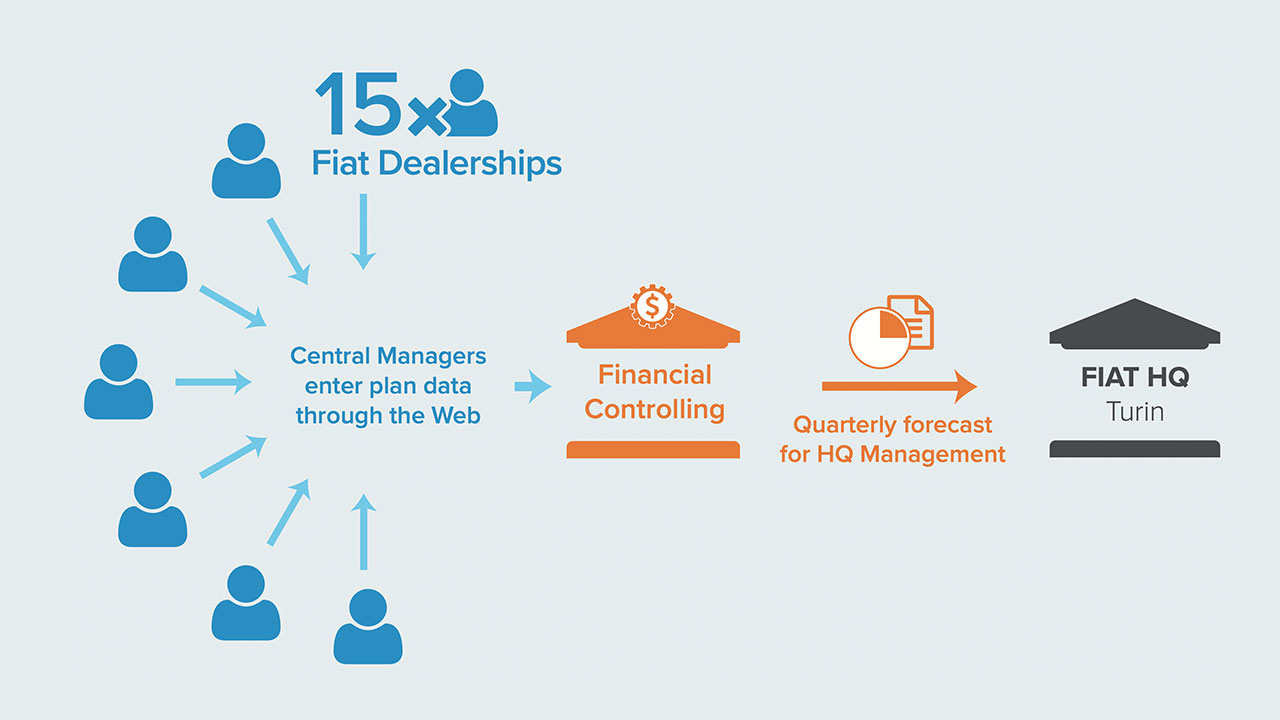
The planning solution calculates and consolidates data the moment it is entered through the Jedox web interface.
Accelerate processes in your specific sales planning
The sales planning process can be strengthened considerably by having a performance management component that employs a model customized to the sales process.
What’s more, multiple people should be contributing to the Sales Performance Management: Instead of having a corporate analyst guru punching in all the numbers, data should be entered directly by all relevant personnel (e.g., product SMEs, local or regional sales executives). In line with the organizational structures and size of a company, you should involve several people – especially as these people will take ownership of their own KPIs.
At the same time, they are typically less familiar with data architecture, planning tools and their specific features; consequently, the more comfort provided to this group, the better and faster the process will go.
The specific requirements for sales planning software are:
- Flexible data structures without the need to tediously create static data models
- Having intuitive, easy-to-use input forms
Moreover, having a clearly defined workflow in place is recommended, because if many people are contributing, it is easy to lose sight of who submitted, consolidated, checked, or corrected data when and why. To control the process, a traceable workflow is essential, so you know the status of your data and who has the right to update this status.
Simple trumps complex
Nothing is more challenging for a sales planner than organizational and structural changes: mergers and acquisitions, new product launches, new sales channels and so on. Overly complicated systems struggle with change because they require the user to do the work of a developer and to maintain and set up complex structures (e.g., metadata) to introduce new items.
As a result, planners generally need support from IT specialists. Sales needs to assess and approve additional resources and introduce specialists to the specific task at hand, considerably slowing time to execution, particularly the process for complex what-if scenario planning (What if we acquire this company? What if we introduce this new product?).
So having a system that is easy for both the sales executives and sales personnel to leverage without IT involvement is key. There simply isn’t time in the planning process for an alternative that involves IT to be effective, let alone efficient.
Providing comparative values and efficient planning processes
It is crucial that the sales planning process has comparative values provided. You cannot collect good planning data on an empty basis. Providing good comparison figures – accurately, at the right level of detail – helps ensure quality in the data collection process. For example, in this year’s plan you could provide the actuals from last year.
This provision is not always easy because the data for comparison may not yet be available. If you’re planning sales for next year, the current year isn’t final. So essentially with your sales forecasting software two forecasts need to be prepared: Out of the actual data you need to prepare a year-end forecast first. Then, based on that, plan one for next year.
A whole host of data can be involved, particularly in the second forecast: budgets, actuals, other forecasts, and strategic planning data that extends beyond the year ahead. All these data need to be accounted for when collecting additional insight – you must have data from previous planning processes built into the next process, and you have to collect actual data and drill down to the proper level of granularity to enable sound decision-making.
Companies should be able to always compare their planning and actual data to evaluate performance, assess future sales and identify operating units whose results didn’t meet expectations.
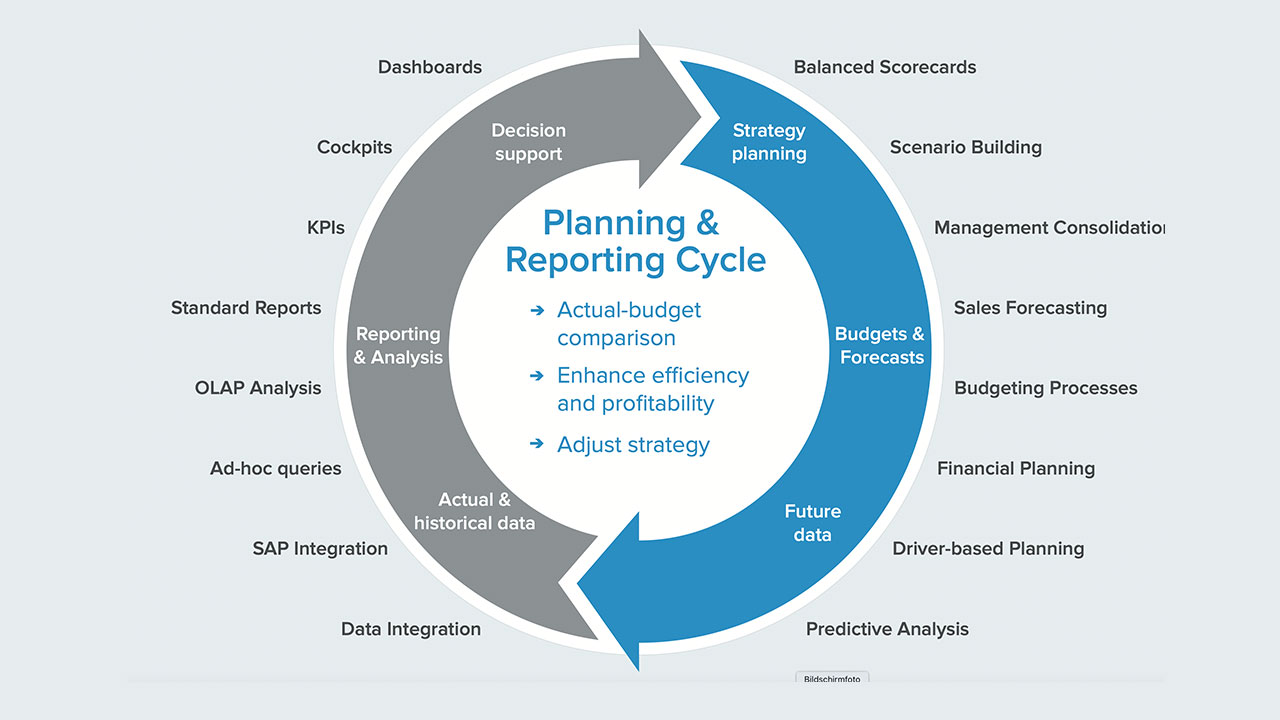
Usage and implementation of sales planning software without IT skills
A good infrastructure facilitates data input. Look to web-based systems that make it easy to deploy input forms and bring the sales planning tools to the users.
Ease of use is also very important. Most sales personnel will be reasonably familiar with Excel, but few are likely to be programmers or particularly IT savvy (Remember 50 percent of companies cited lack of skilled resources as a major challenge to planning).
An easy-to-use system is one that even personnel with average-to-good Excel skills find easy to operate and can manage independently. No programming skills should be required, nor should IT have to be involved. Such a system facilitates adoption and effective usage while minimizing the need for training. Subject matter experts should be able to easily design and implement forms, eliminating the need for external or IT specialists to have to be consulted during implementation.
The best planning tools also let you use the system on a tablet or smartphone. In today’s increasingly mobile business environment, this is a clear advantage. Sales executives and managers can get access to important data anywhere, anytime; and planning data can easily be entered on the go, directly into the database, helping keep a finger on the pulse as it changes on the ground.
Top-down versus bottom-up – which is more efficient for planning?
In companies where the sales planning is organized top-down, a relatively small number of individuals determine the course of the process. Personnel and teams closest to the data are marginalized from the planning process, meaning that planners base their forecasts on inconclusive data input.
In companies with a bottom-up approach to the process, data is generated by CSOs in the field and rolled up to management. The downside here is a tendency to be overly conservative as a means of “protecting” against future shortfalls. This makes the quality of data suspect.
The most successful companies use a combination of top-down and bottom-up planning. Top-down is used to set threshold values, then bottom-up input is compared within the framework of those boundaries. By making this comparison, necessary changes are more likely to come to light. Adjustments and readjustments can be fine-tuned in either direction during the process.
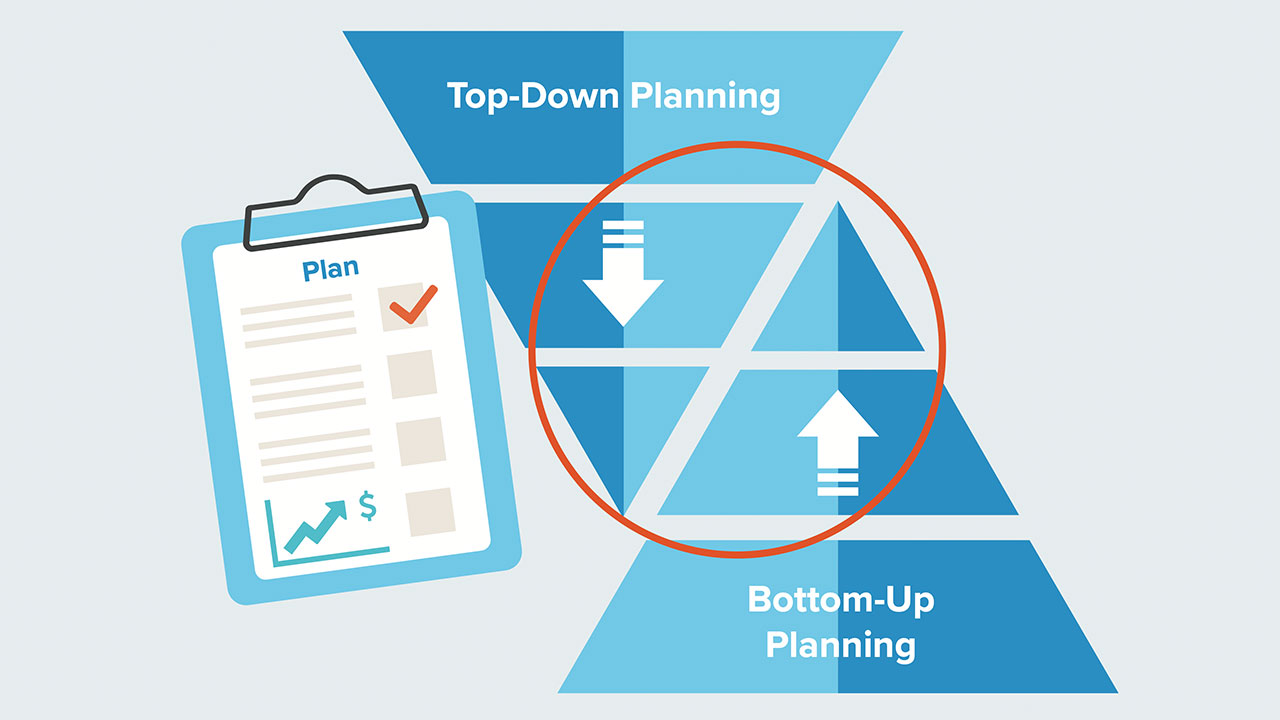
Planning tools must be flexible and accommodate change
Because the pace of change is accelerating, and the sources of that change proliferating, it’s imperative that planning tools be highly flexible. This is particularly vital for getting a grasp on demand volatility and being able to implement and analyze what-if scenarios quickly and smoothly. The planning for these scenarios is often done in parallel.
Such different scenarios need to be compared so that management can consider the revenue and profit impact of varying assumptions.
To enable this process, planning tools need to be highly flexible and freely configurable, allowing planners to add or remove factors in a scenario at will.
Sales planning is driver-based. This means, input values in the planning process, such as from customers, deals or sales, are drivers rather than actual values. This means that effective tools must be designed to calculate for the planning process, which is different from adapting calculations used for actuals (the latter being quite different and less effective in allowing planners to focus on the right elements for their sales forecasting).
What sales needs to succeed
Organizations have more data available than ever before and to have confidence in the sales planning process, a sales executive needs an overview of all the data used to produce the plan, as well as the assurance that the data is absolutely reliable. Often, this is simply not the case. An effective sales planning tool will easily integrate into existing systems as a means of providing a single source of truth, rather than muddying the vision with proliferating systems that crash into chaos.
Providing this unified view across the company is the litmus test for any effective sales planning solution and tops the list of important tips you should follow when considering the implementation of sales planning technology.
5 tips you should follow when considering the implementation of sales planning technology:
- Ensure that it provides you with a “Single Source of Truth”.
- Your sales planning tool should integrate easily with other critical systems, like ERP and CRM.
- Your sales planning tool should minimize risks by simplifying the planning process and delivering data how and when you need it. Minimize capital risk by paying attention to whether you can try before you buy, if you can subscribe, or whether you must buy the product outright. Calculate the ROI: How rapidly can you gain from the investment?
- Pay attention to the development path for the tool. Does it have flexible cloud-based or hybrid implementation options – or only on-premises? Additionally, you should be able to use your sales planning solution on mobile devices without any restrictions, so that you have unlimited access to data at any time and from any place.
- Finally, the solution should facilitate collaboration across everyone providing input into the sales planning process: That means, it should fit flexibly into your individual working conditions. You should also make sure the solution is user-friendly so that you can use it without involving IT.
While this list is not exhaustive, following these recommendations will get you an important step closer to improving your sales planning. And it is possible! Processes can be turned into an asset by taking data-based decisions to close the performance gaps associated with Sales and Operations Planning (S&OP). The result: increased knowledge leading to increased turnover.





